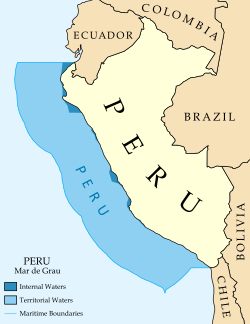
The Mar de Grau (Spanish : Grau's Sea) is the official name for the body of water in the Pacific Ocean under the control of the South American country of Peru. [1] This body of water extends in length approximately 3,079.50 km, from the parallel of the Boca de Capones in northern Peru to the parallel of the Punto Concordia and the parallel in front of the city of Tacna in southern Peru. In terms of width, the maritime zone extends from the Peruvian coast to 200 nautical miles (370.4 km) into the Pacific Ocean.